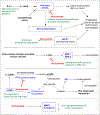Molecules targeting the androgen receptor (AR) signaling axis beyond the AR-Ligand binding domain
- PMID: 30565725
- PMCID: PMC6608750
- DOI: 10.1002/med.21548
Molecules targeting the androgen receptor (AR) signaling axis beyond the AR-Ligand binding domain
Abstract
Prostate cancer (PCa) is the second most common cause of cancer-related mortality in men in the United States. The androgen receptor (AR) and the physiological pathways it regulates are central to the initiation and progression of PCa. As a member of the nuclear steroid receptor family, it is a transcription factor with three distinct functional domains (ligand-binding domain [LBD], DNA-binding domain [DBD], and transactivation domain [TAD]) in its structure. All clinically approved drugs for PCa ultimately target the AR-LBD. Clinically active drugs that target the DBD and TAD have not yet been developed due to multiple factors. Despite these limitations, the last several years have seen a rise in the discovery of molecules that could successfully target these domains. This review aims to present and comprehensively discuss such molecules that affect AR signaling through direct or indirect interactions with the AR-TAD or the DBD. The compounds discussed here include hairpin polyamides, niclosamide, marine sponge-derived small molecules (eg, EPI compounds), mahanine, VPC compounds, JN compounds, and bromodomain and extraterminal domain inhibitors. We highlight the significant in vitro and in vivo data found for each compound and the apparent limitations and/or potential for further development of these agents as PCa therapies.
Keywords: androgen receptor; androgen receptor DNA-binding domain; androgen receptor degradation; androgen receptor signaling axis; androgen receptor transactivation domain; castration-resistant prostate cancer; prostate cancer.
© 2018 Wiley Periodicals, Inc.
Conflict of interest statement
Figures






References
-
- van Royen ME, van Cappellen WA, de Vos C, Houtsmuller AB, Trapman J. Stepwise androgen receptor dimerization. J Cell Sci 2012;125(Pt 8):1970–1979. - PubMed
-
- Cancer.gov. Cancer of the Prostate: SEER Stat Fact Sheets.
Publication types
MeSH terms
Substances
Grants and funding
LinkOut - more resources
Full Text Sources
Other Literature Sources
Research Materials

